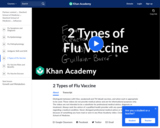
Distinguish between LAIV (live, weakened) and TIV (dead) vaccines, and when each is appropriate to be used.
- Subject:
- Disease
- Health and Medical Science
- Material Type:
- Lesson
- Provider:
- Khan Academy
- Author:
- Khan Academy
- Date Added:
- 09/22/2013

Distinguish between LAIV (live, weakened) and TIV (dead) vaccines, and when each is appropriate to be used.

What causes addiction? Easy, right? Drugs cause addiction. But maybe it is not that simple. The video "Addiction" is a resource included in the Disease topic made available from the Kurzgesagt open educational resource series.

Take a glimpse into your lungs to understand what happens when you have an asthma attack.

Learn the mechanics of breathing, and how breathing air in is quite different from breathing air out.

This presentation will provide the basics for lung cancer patient care with updated guidelines and needs prior to starting the treatment process. We will start with symptoms leading to diagnosis and the steps that one will go through to obtain accurate information to start treatment. It is an ever-evolving process with lung cancer to help increase survival and quality of life.

An overview of genitourinary oncology, including a discussion of prostate, bladder, kidney, and testis cancers and associated oncology-related professions, as well as a discussion of the needs specific to genitourinary oncology patients

This lecture provides an overview of the types of cancers experienced by pediatric patients, and includes a discussion of the treatment options, management of side effects, and the emotional needs of patients and their family. The presentation also includes a review of pediatric patient outcomes with various therapies and a discussion of the importance of collaboration and teamwork in enhancing the quality of care and outcomes.
Lecture Objectives
-Describe the types, stages and diagnostic tests available for treating pediatric cancer patients.
-Discuss the treatment options, management of side effects and emotional needs of pediatric cancer
patients and their families.
-Review pediatric patient outcomes with therapy.
-Discuss the importance of collaboration and teamwork to enhance quality of care and patient
outcomes. This includes an emphasis on the family for pediatric patients.

How to care for the breast cancer patient using multiple modalities; medical oncology, surgical oncology, and radiation oncology, with a brief examination of chemotherapy side effects and financial toxicities of treatment, a lecture for nursing students. The lecture will include diagnostic vs screening mammograms, biopsies, excisional biopsy, lumpectomy, mastectomy, lymph node management and lymphedema prevention, and management. Discussion will cover pre-op and post-op management. Lecture will not cover breast reconstruction.

This lecture provides an overview of breast cancer types and stages and the diagnostic tests available for treating breast cancer patients. Information is included about the treatment options, management of side effects, and emotional needs of patients. The lecture also discusses the importance of collaboration and teamwork to enhance quality of care and patient outcomes.
Learning Outcomes:
• Describe the types, stages and diagnostic tests available for treating breast cancer patients.
• Discuss the treatment options, management of side effects, and emotional needs of patients with breast cancer.
• Discuss the importance of collaboration and teamwork to enhance quality of care and patient outcomes.

This lecture provides an overview of lung cancer types and stages and the diagnostic tests available for treating lung cancer patients. Information is included about the treatment options, management of side effects, and emotional needs of patients. The lecture also discusses the importance of collaboration and teamwork to enhance quality of care and patient outcomes.
Learning Outcomes:
• Describe the types, stages and diagnostic tests available for treating lung cancer patients.
• Discuss the treatment options, management of side effects, and emotional needs of patients with lung cancer.
• Discuss the importance of collaboration and teamwork to enhance quality of care and patient outcomes.

This lecture provides an overview of prostate cancer, stages and the diagnostic tests available for treating prostate cancer patients. Information is included about the treatment options, management of side effects, and emotional needs of patients. The lecture also discusses the importance of collaboration and teamwork to enhance quality of care and patient outcomes.
Lecture Objectives
-Describe the types, stages and diagnostic tests available for treating prostate cancer patients.
-Discuss the treatment options, management of side effects and emotional needs of patients with prostate cancer.
-Discuss the importance of collaboration and teamwork to enhance quality of care and patient outcomes.

We will provide an introduction to blood cancers including risk factors, epidemiology, presenting symptoms, general treatment, and caregiver and survivorship issues. We will also discuss the multidisciplinary approach to taking care of patients with hematologic malignancies.

This lecture provides an overview of the world of resources that are available to patients and care givers who are navigating a cancer experience.
Lecture Objectives
-Define the different types of cancer treatment facilities available in North Carolina.
-Explain how to select credible resources and utilize them in the most effective way possible.
-Describe the types of resources that are available to the NC cancer patient, including:
-Pharmacy assistance/medication assistance programs for different types of cancer.
-Benefits and financial resources (Medicaid, Medicare, Disability and grants).
-Legal resources.
-Psycho-social cancer support and survivorship programs.

Link to a repository of public domain images that are related to delirium, many of which appear in peer-reviewed literature that is in the public domain. Includes both algorithms for managing delirium, tables from published articles, as well as diagrams of neurotransmitters

Find out how we can use clinical clues to help figure out if someone has active TB infection.

Learn the different types of drug-resistant TB

What does the Ebola virus actually do in your body? Why is it so dangerous and why does it kill so many people? We take a look at the apocalyptic war that rages in the body after an infection by the Ebola virus and the soldiers fighting. The video "The Ebola Virus Explained - How Your Body Fights For Survival" is a resource included in the Disease topic made available from the Kurzgesagt open educational resource series.

This presentation discusses the end-of-life care options that are available to patients experiencing cancer. The presenter also discuss resources that are available to family members during the cancer journey.

This presentation discusses the end-of-life care options that are available to patients experiencing cancer. The presenter also discuss resources that are available to family members during the cancer journey.
Lecture Objectives:
-Distinguish between the palliative care and hospice care services that are available to cancer patients.
-Define the providers, admittance requirements, care structure, and expense coverage available for palliative and hospice care services.
-Discuss the importance of collaboration and teamwork to enhance quality of end-of-life care for cancer patients.
-Identify resources that are available to patients and families to learn more about palliative and hospice care services.

The flu has been causing disease and death for a long time. Get a feel for exactly how many folks are affected each year by this disease.